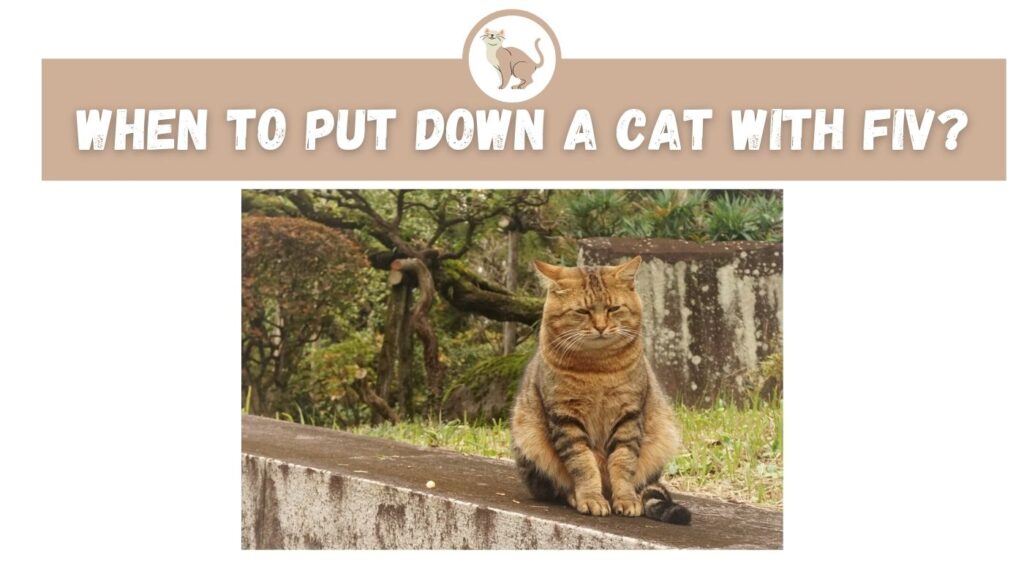If you are a cat owner or a cat lover, you have probably heard the term FIV in regards to the health of a cat. “FIV Positive” or “FIV Negative” is something that is often referred to at a vets office.
But what exactly is FIV, and how dangerous is it? Can a cat live with FIV? And how do you know when to put a cat down if it has FIV?
What is FIV?
FIV sounds pretty scary, especially because it is commonly referred to as cat HIV or cat AIDS. FIV stands for feline immunodeficiency virus, and is nicknamed as cat HIV or AIDS because it effects cats similarly to how those diseases effect a human- by attacking and weakening the immune system.
Fortunately for cat lovers, FIV can not be transmitted to humans.
FIV is a virus that infects a cat for life and is incredibly contagious amongst cats. Most commonly transferred via bits, FIV can also be transmitted by grooming, sneezing, or even by sharing a litter box.
For this reason, many experts do not recommend housing an FIV positive cat with a cat that does not have FIV. Doing so increases the risk of the cat that doesn’t have FIV catching it.
Cats that have FIV can live symptom free for years before the virus starts to show its dangerous colors. A cat with FIV usually shows the following symptoms: fever, lack of appetite, chronic infections, pooping in the house all of a sudden, diarrhea, eye problems, and weight loss.
Because FIV is a virus that attacks a cat’s immune system, these cats are very susceptible to catching other viruses or developing other health conditions. If this happens, it can be deadly.
Can a cat live with FIV?
Many people find out that a cat has FIV and automatically assume that it is going to die soon. This isn’t always the case! Many cats with FIV can live symptom free for years.
Once the symptoms start, they can often be treated with various medications. Some cats may live for months while others can live for many years. On average, a cat with FIV will live for 5 years.
Cats with FIV can spread their disease to unaffected cats. Therefore, it is important to consult vets when thinking about adopting an FIV positive cat.
FIV positive cats can thrive in clean and stress free environments. This means that providing plenty of scratching posts, beds, hideaways, and a clean litter box is an essential part of owning a cat with FIV.
Owning a cat with FIV also comes with a lot of visits to the vet. This means they can cost a lot of money. FIV positive cats are often kept on parasite medication regardless if they are indoor or outdoor, just to be extra cautions. Bloodwork also might need to be done regularly along with getting medications to control any symptoms that your cat might develop from having FIV. Your vet may also suggest a specific diet to help keep symptoms and outbreaks under control.
When to Put Down a Cat With FIV?
While a cat with FIV can develop dangerous symptoms, you might not need to put your FIV positive cat down.
The general rule of thumb when it comes to putting a cat with FIV down is to asses the cat’s quality of life.
If it appears as though a cat can live comfortably for a few (or many) more years while on medication, then you do not need to put your cat down. However, if your cat is frequently in pain or uncomfortable, I would suggest you put him/her down.
Most of the time a cat that has FIV is only going to need to be put down if it develops another health condition on top of the FIV. They might also need to be put down if the symptoms that come with FIV become sever.
The most important this is to always seek out the advice of a vet before making a decision. Sometimes things look worse than they seem, especially to someone that isn’t well versed in all things cat health related. You should also remember that there might be medication that can alleviate the symptoms of FIV.
It is also very important to never take matters into your own hands. If your vet does recommend you put your cat down, you should get him/her euthanized at a vet office.

